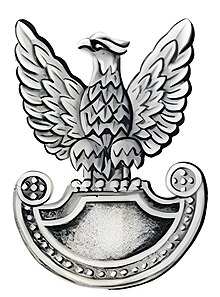Polish People's Army
The Polish People's Army[1] was the second formation of the Polish Armed Forces in the East in 1943–1945, and in 1945–1989 the armed forces of the Polish communist state, the Polish People's Republic. It was under the command of the Polish Workers' Party and then the Polish United Workers' Party. The communist-led Polish armed forces, allowed by Joseph Stalin, were the result of efforts made in the early 1940s in the Soviet Union by Wanda Wasilewska and Zygmunt Berling.
During World War II, two armies of the Polish Army were formed, which included 10 infantry divisions, 5 armored brigades, a cavalry brigade, 2 sappers' brigades, 3 divisions and several artillery brigades and smaller units, as well as 4 aviation divisions. At the end of 1944, there were about 180,000. people.
After the war the Polish Army was reorganized into six (later seven) military districts. These were the Warsaw Military District, the Lublin Military District, the Kraków Military District, the Łódź Military District, the Poznań Military District, the Pomeranian Military District, HQ in Toruń, and the Silesian Military District, HQ in Katowice.
On 7 October 1950, the anniversary of the Battle of Lenino was declared the official "Day of the Polish People's Army" by the authorities of the People's Republic.
In 1955, Poland joined the Warsaw Pact military alliance , which was created in response to the inclusion of the Federal Republic of Germany in the NATO alliance. The agreement was signed on May 14, 1955 in Warsaw.[2]
References
change- ↑ Popularna Encyklopedia Powszechna Wydawnictwa Fogra (2016). "Pierwsza Armia Wojska Polskiego". Encyklopedia WIEM. Archived from the original on 2016-11-06. Retrieved 2024-03-08.
{{cite journal}}: Cite journal requires|journal=(help) - ↑ Sardemann, Gerhard (2010-08-01). "Die Welt aus den Angeln heben". TATuP - Zeitschrift für Technikfolgenabschätzung in Theorie und Praxis. 19 (2): 8–17. doi:10.14512/tatup.19.2.8. ISSN 2199-9201.
